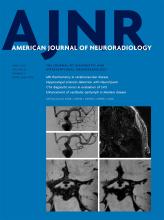Index by author
Vajapeyam, S.
- PediatricsOpen AccessAdvanced ADC Histogram, Perfusion, and Permeability Metrics Show an Association with Survival and Pseudoprogression in Newly Diagnosed Diffuse Intrinsic Pontine Glioma: A Report from the Pediatric Brain Tumor ConsortiumS. Vajapeyam, D. Brown, C. Billups, Z. Patay, G. Vezina, M.S. Shiroishi, M. Law, P. Baxter, A. Onar-Thomas, J.R. Fangusaro, I.J. Dunkel and T.Y. PoussaintAmerican Journal of Neuroradiology April 2020, 41 (4) 718-724; DOI: https://doi.org/10.3174/ajnr.A6499
Vaussy, A.
- EDITOR'S CHOICEHead & NeckYou have accessComparison of Enhancement of the Vestibular Perilymph between Variable and Constant Flip Angle–Delayed 3D-FLAIR Sequences in Menière DiseaseS. Nahmani, A. Vaussy, C. Hautefort, J.-P. Guichard, A. Guillonet, E. Houdart, A. Attyé and M. EliezerAmerican Journal of Neuroradiology April 2020, 41 (4) 706-711; DOI: https://doi.org/10.3174/ajnr.A6483
The authors compared the degree of perilymphatic enhancement and the detection rate of endolymphatic hydrops using constant and variable flip angle sequences in 16 patients with 3T MR imaging. Both for symptomatic and asymptomatic ears, the median signal intensity ratio was significantly higher with the constant flip angle than with the heavily-T2 variable flip angle. Cochlear blood-labyrinth barrier impairment was observed in 4/18 symptomatic ears with the heavily-T2 variable flip angle versus 8/19 with constant flip angle sequences. They conclude that 3D-FLAIR constant flip angle sequences provide a higher signal intensity ratio and are superior to heavily-T2 variable flip angle sequences in reliably evaluating the cochlear blood-labyrinth barrier impairment.
Vegh, D.
- FELLOWS' JOURNAL CLUBAdult BrainOpen AccessHippocampal Sclerosis Detection with NeuroQuant Compared with NeuroradiologistsS. Louis, M. Morita-Sherman, S. Jones, D. Vegh, W. Bingaman, I. Blumcke, N. Obuchowski, F. Cendes and L. JehiAmerican Journal of Neuroradiology April 2020, 41 (4) 591-597; DOI: https://doi.org/10.3174/ajnr.A6454
The authors reviewed 144 adult patients who underwent presurgical evaluation for temporal lobe epilepsy. The reference standard for hippocampal sclerosis was defined by having hippocampal sclerosis on pathology (n=61) or not having hippocampal sclerosis on pathology (n=83). Sensitivities, specificities, positive predictive values, and negative predictive values were compared between NeuroQuant analysis and visual MR imaging analysis. Visual MR imaging analysis by a neuroradiologist with expertise in epilepsy had a higher sensitivity than did NeuroQuant analysis, likely due to the inability of NeuroQuant to evaluate changes in hippocampal T2 signal or architecture. Given that there was no significant difference in specificity between NeuroQuant analysis and visual MR imaging analysis, NeuroQuant can be a valuable tool when the results are positive, particularly in centers that lack neuroradiologists with expertise in epilepsy, to help identify and refer candidates for temporal lobe epilepsy resection.
Vezina, G.
- PediatricsOpen AccessAdvanced ADC Histogram, Perfusion, and Permeability Metrics Show an Association with Survival and Pseudoprogression in Newly Diagnosed Diffuse Intrinsic Pontine Glioma: A Report from the Pediatric Brain Tumor ConsortiumS. Vajapeyam, D. Brown, C. Billups, Z. Patay, G. Vezina, M.S. Shiroishi, M. Law, P. Baxter, A. Onar-Thomas, J.R. Fangusaro, I.J. Dunkel and T.Y. PoussaintAmerican Journal of Neuroradiology April 2020, 41 (4) 718-724; DOI: https://doi.org/10.3174/ajnr.A6499








